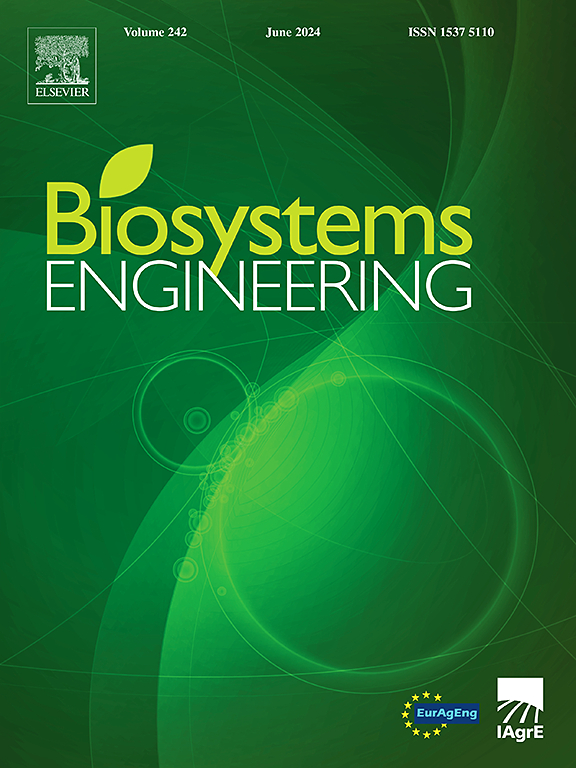Regional airflow velocity control to meet the diverse requirements of unevenly distributed maize threshing mixtures
IF 5.3
1区 农林科学
Q1 AGRICULTURAL ENGINEERING
引用次数: 0
Abstract
Cleaning is a critical operation in maize production. Uneven lateral distribution of maize threshing mixture on the cleaning sieve surface is a common issue, which can lead to material overload or underload in certain regions, severely impacting the quality of the cleaning operation. This paper designs a combined cleaning fan, consisting of three fans that can independently control their speed, achieving precise airflow control over three regions of the cleaning sieve surface. A monitoring device is designed to detect the load distribution of maize threshing mixture in real-time, providing signals for the control of the combined fan. Material load, vibration frequency of the cleaning sieve, and sieve opening are used as the input layer, while fan speed serves as the output layer. A Gradient Boosting Regression (GBDT) fan speed prediction model is established to provide a data model for the precise control of the combined fan. A control system for the combined fan is developed, adjusting the fan speed in real-time based on model calculations. Cleaning performance tests showed that the combined fan control system precisely adjusted fan speed according to changes in material load, enabling differentiated operations for unevenly distributed threshing mixture, thereby achieving lower loss rates and impurity levels. Compared to traditional fans, the combined fan demonstrated superior operational performance. The combined cleaning fan improved airflow mismatch caused by uneven threshing mixture distribution, significantly enhancing maize cleaning performance. It also provides a valuable reference for the cleaning operations of other crops and the intelligent development of agricultural machinery.
区域气流速度控制,以满足玉米脱粒混合物分布不均匀的多样化要求
清洗是玉米生产中的一项关键操作。玉米脱粒混合物在清洗筛表面横向分布不均匀是一个普遍存在的问题,它会导致物料在某些区域过载或欠载,严重影响清洗作业的质量。本文设计了一种组合式清洗风机,由三个风机组成,可独立控制转速,实现了清洗筛表面三个区域的精确气流控制。设计了一种监测装置,实时检测玉米脱粒混合物的负荷分布,为组合风机的控制提供信号。物料负荷、清洗筛振动频率、筛开度作为输入层,风机转速作为输出层。建立了梯度增强回归(GBDT)风机转速预测模型,为组合式风机的精确控制提供数据模型。开发了组合式风机控制系统,根据模型计算,实时调节风机转速。清洗性能试验表明,组合式风机控制系统可根据物料负荷的变化,精确调节风机转速,对分布不均匀的脱粒混合物进行差异化操作,降低脱粒损失率和杂质含量。与传统风机相比,组合式风机的运行性能更加优越。组合式清洗风机改善了脱粒混合物分布不均匀造成的气流失配,显著提高了玉米的清洗性能。也为其他农作物的清洗作业和农业机械的智能化发展提供了有价值的参考。
本文章由计算机程序翻译,如有差异,请以英文原文为准。
求助全文
约1分钟内获得全文
求助全文
来源期刊

Biosystems Engineering
农林科学-农业工程
CiteScore
10.60
自引率
7.80%
发文量
239
审稿时长
53 days
期刊介绍:
Biosystems Engineering publishes research in engineering and the physical sciences that represent advances in understanding or modelling of the performance of biological systems for sustainable developments in land use and the environment, agriculture and amenity, bioproduction processes and the food chain. The subject matter of the journal reflects the wide range and interdisciplinary nature of research in engineering for biological systems.
 求助内容:
求助内容: 应助结果提醒方式:
应助结果提醒方式:


